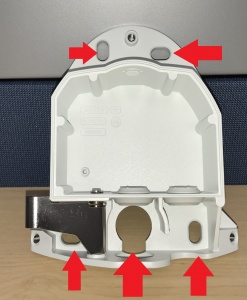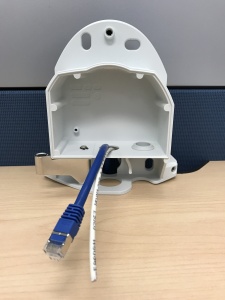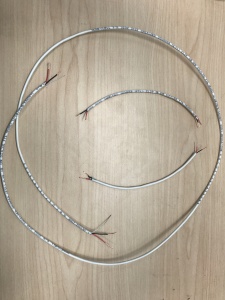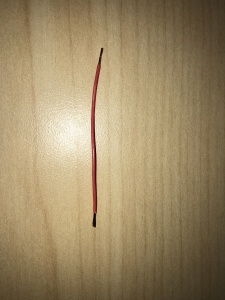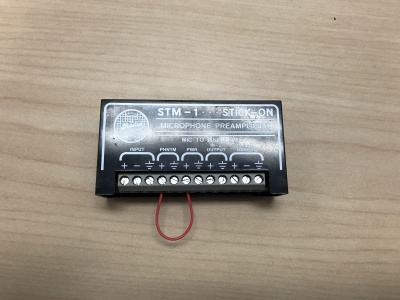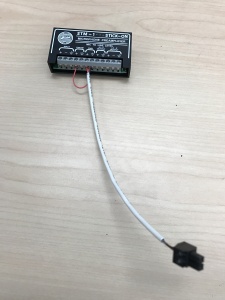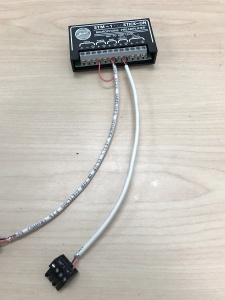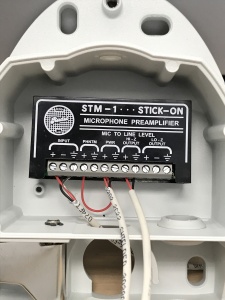Difference between revisions of "Installing an Axis P5414/P5415 with a Shure MX202i Microphone"
IVSWikiBlue (talk | contribs) |
IVSWikiBlue (talk | contribs) |
||
| Line 41: | Line 41: | ||
#Connect one end of the 1 inch audio cable to the +PWR terminal and connect the other end of that into the +PHNTM terminal. | #Connect one end of the 1 inch audio cable to the +PWR terminal and connect the other end of that into the +PHNTM terminal. | ||
| − | #:[[Phantom PWR STM.JPG|400x300px]] | + | #:[[File:Phantom PWR STM.JPG|400x300px]] |
#Connect one of the 4 inch cables to both PWR terminals (Red to +, Black to the other terminal) of the STM-1. Connect the other side to the power phoenix connector (Red to +, Black to –) | #Connect one of the 4 inch cables to both PWR terminals (Red to +, Black to the other terminal) of the STM-1. Connect the other side to the power phoenix connector (Red to +, Black to –) | ||
#:[[File:STM_Powered_Connected.JPG|400x300px]] | #:[[File:STM_Powered_Connected.JPG|400x300px]] | ||
Revision as of 16:53, 3 January 2017
Required Parts And Tools
- Axis P5415 or P5415
- RDL STM-1
- XLR-F Pigtail
- Shure MX202i Microphone
- Starbit Security Driver
- Wire Stripper
- Anchors and Screws
- 1/2" paddle bit
- 1 blank single gang wall plate
- Toggle Bolts (If mounting to drop ceiling tile)
- Drill bit and drill
- Phillips head drill bit or Phillips head screwdriver
- Small Flat head screwdriver
- Hole Saw

- B Connectors

- Stud Finder
- Cat5/6 Patch Cable (7ft-15ft recommended)
- 22/2 Gauge Wire
- Fish Tape or Glow Rod

Installation Instructions
- Locate the network drop that is ran back to the HIGH POE switch. (If the switch does not have HIGH POE, you will need to insert a HIGH POE injector back at the network closet).
- Remove the P5414/P5415 camera from its base with the starbit security driver. Place the base of the camera on the wall where you’d like to mount. Using a stud finder, ensure there aren’t any studs any behind the camera base. Using a marker or pen, mark the 4 areas on the wall where the screws would be and also mark the opening where the any cabling would come through (Areas labeled on picture).
- Using the drill bit, drill the 4 screw markers and place the anchors inside. Using the hole saw (recommended size 2” inches or less), drill a hole into the area where cables would come through.
- Above drop ceiling, locate the network drop. IF it is on a biscuit, you will need the patch cable. If there is an RJ-45 at the end of the drop, the patch cable won’t be needed. Using the hole saw, drill a hole above the drop ceiling in line with the hole drilled where the camera will be mounted. If there isn’t any drywall above the ceiling, adjust accordingly to your circumstance.
- Using your glow rod or fish tape, fish the network drop and a section of 22/2 audio cable up the drywall. The section of audio cable should be long enough to reach the destination where the Shure MX202i microphone will be mounted in your drop ceiling. This cable will be for your microphone. (If using 2 microphones, run 2 cables).
- Mount the Axis P5414/5415 base to the wall using the screws associated with the anchors. Remove the middle rubber piece on the camera base and run your network drop and audio cable the hole on the base attached to the wall and through the hole where you just removed the rubber piece.
- Cut 2 additional pieces of 22/2 cable approximately 4 inches long. Strip the jacket off the 22/2, revealing the red, black, and common (bare wire) on both sides of the cable. Remove the string and plastic casings covering the red and black cables. Strip the red and black jackets off the wire exposing the copper. Cut copper evenly on both ends (See picture). On the two 4 inch cables, remove the common (bare wire) completely.
- You will also need to cut another shorter piece of 22/2 cable (approx. 1 inch). Strip the jacked and from the cable and remove all contents keeping only the red cable. On both ends of the red cable, strip off a piece of the jacked (See picture).
Next, we will wire the STM-1 for use. For this, you will need the audio phoenix connector and power phoenix connector that come included in the P5414/P5415
- Connect one end of the 1 inch audio cable to the +PWR terminal and connect the other end of that into the +PHNTM terminal.
- Connect one of the 4 inch cables to both PWR terminals (Red to +, Black to the other terminal) of the STM-1. Connect the other side to the power phoenix connector (Red to +, Black to –)
- Connect the second of the 4 inch cables to both HI-Z OUTPUT terminals (Red to +, Black to the other terminal) of the STM-1. Connect the other side to the audio in portion of the audio phoenix connector (Red to +, Black to –).
- Connect the audio cable that is intended for your microphone to the input terminals of the STM-1 (Red to +, Black to -, Common to the common terminal). Using the Velcro that comes with the STM-1, attach the STM-1 to the back base of the cameras.








